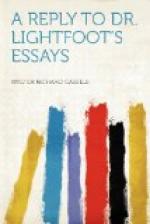With regard to Polycrates of Ephesus I need say very little. Eusebius preserves a passage from a letter which he wrote “in the closing years of the second century,” [137:3] when Victor of Rome attempted to force the Western usage with respect to Easter on the Asiatic Christians. In this he uses the expression “he that leaned on the bosom of the Lord,” which occurs in the fourth Gospel. Nothing could more forcibly show the meagreness of our information regarding the Gospels than that such a phrase is considered of value as evidence for one of them. In fact the slightness of our knowledge of these works is perfectly astounding when the importance which is attached to them is taken into account.
VI.
THE CHURCHES OF GAUL.
A severe persecution broke out in the year A.D. 177, under Marcus Aurelius, in the cities of Vienne and Lyons, on the Rhone, and an account of the martyrdoms which then took place was given in a letter from the persecuted communities, addressed “to the brethren that are in Asia and Phrygia.” This epistle is in great part preserved to us by Eusebius (H.E. v. 1), and it is to a consideration of its contents that Dr. Lightfoot devotes his essay on the Churches of Gaul. But for the sake of ascertaining clearly what evidence actually exists of the Gospels, it would have been of little utility to extend the enquiry in Supernatural Religion to this document, written nearly a century and a half after the death of Jesus, but it is instructive to show how exceedingly slight is the information we possess regarding those documents. I may at once say that no writing of the New Testament is directly referred to by name in this epistle, and consequently any supposed quotations are merely inferred to be such by their similarity to passages found in these writings. With the complete unconsciousness which I have pointed out that Dr. Lightfoot affects regarding the object and requirements of my argument, Dr. Lightfoot is, of course, indignant that I will not accept as conclusive evidence the imperfect coincidences which alone he is able to bring forward. I have elsewhere fully discussed these, [140:1] and I need only refer to some portions of his essay here.
“Of Vettius Epagathus, one of the sufferers, we are told that, though young; he ’rivalled the testimony borne to the elder Zacharias ([Greek: sunexisousthai te tou presbuterou Zacharious marturia]), for verily ([Greek: goun]) he had walked in all the commandments and ordinances of the Lord blameless.’ Here we have the same words, and in the same order, which are used of Zacharias and Elizabeth in St. Luke (i. 6): ’and Zacharias, his father, was filled with the Holy Ghost.’” [140:2]
Dr. Lightfoot very properly dwells on the meaning of the expression “the testimony of Zacharias” ([Greek: te Zachariou marturia]), which he points out “might signify either ‘the testimony




